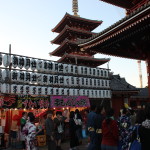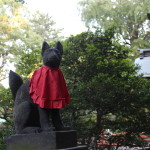You may recall a stone garden when you hear a word “Japanese garden”. Yes, it is one type of Japanese garden out of three types. Let’s see what types of traditional gardens you can enjoy in Japan.
1) chisen teien (pond garden)
It is a type of Japanese garden with a pond in the center and most often observed in many regions of Japan. Usually it is large and you are supposed to enjoy the garden by walking around the pond. Its origin dates back to gardens of nobility in 7th century and established during Edo period (1603-1867). The ones made during this period have several view spots which imitated famous landscapes in all over Japan. Often there are small tea houses or arbors in the garden to rest.
The famous gardens of this type are Kairaku-en in Mito, Kenroku-en in Kanazawa, Hamarikyu in Tokyo, Koraku-en in Tokyo, Rokuonji temple in Kyoto, Tenryuji temple in Kyoto, Saihoji temple in Kyoto, and Kairaku-en in Okayama.
2) karesansui teien (dry landscape garden)
It is a type of Japanese garden made of sand and stones by which represent mountains and brook. You are supposed to see it from inside the house. This type began to appear in 14th century when zen spread widely among high class warriors and influenced on their way of thinking. Due to the influence of zen, this type of gardens are highly abstract and spiritual, which require visitors to try to understand the intention of garden designer.
The recommending gardens of this type are Kenninji temple, Entokuin, and Ryoanji temple in Kyoto.
3) roji (a path to tea ceremony)
It is a path leading to a tea house. It was developed as tea ceremony established. Roji literally means bare ground and it is regarded more functional rather than decorative. It is usually composed with stepping stones, stone lantern and stone-made washbasin set on the ground called tsukubai.
The easiest way to see this type of garden is to find a tea house in a pond garden.
Became interested in Japanese gardens? koi Travel offers you unique Japanese garden experiences!


